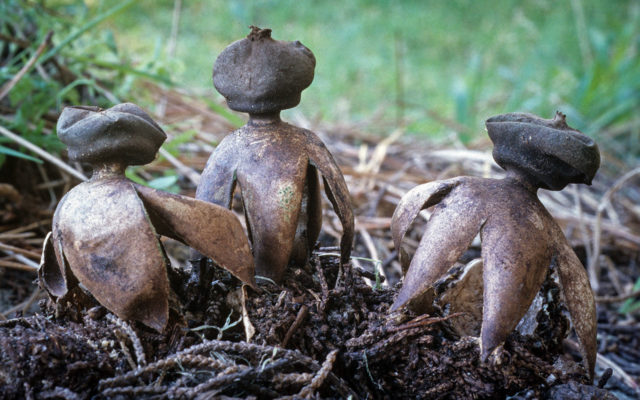Content
The vaulted star mushroom (Geastrum fornicatum) belongs to the Star family and is the rarest type of mushroom. It can only be found in the wild; almost no one engages in mass breeding.
Description of the vaulted star
The vaulted star is also called the earthen vaulted star or earthen star. It has an unusual structure, which is why it got its name: its leg is star-shaped.
In the inner part of the mushroom there is a spore-bearing body of a spherical or oval shape, which rises above a star-shaped stand on a short stalk. The apex of the body is pointed, surrounded by a thin protective covering. It reaches 1-2 cm in diameter, the spore powder has a dark brown color.The fruit part is preserved throughout the entire ripening period.
The outside of the fruiting body is covered by exoperidium, a shell that eventually bursts and opens into 4-10 narrow rays. Their length reaches 3-11 cm. They form a star-shaped stand about 3-15 cm in size.

The outer shell darkens and dries out over time, the flesh becomes coarser
The rays are erect, then grow to a dense and thick mycelial layer of the shell, which remains underground. The spore-bearing body is dark brown or gray in color. The inner side of the rays is lighter - cream or light brown.
Where and how does it grow
This species is extremely rare in Russia. Most common in the European part of the country, it is also found in warm regions with a mild climate: in Eastern Siberia, the Caucasus and the forests of the temperate Russian zone.
Grows in deciduous, coniferous and mixed forests, mainly on sandy and carbonate soils. Most often found on the banks of water bodies, near anthills and under fallen pine needles. Starworts grow in small groups under bushes and in secluded places, forming witches' circles.
Is the mushroom edible or not?
The vaulted starwort belongs to the category of conditionally edible. Before eating, mushrooms must be heat treated: they can be fried, boiled or stewed. In cooking, young starfish are used, the pulp and shell of which has not had time to darken and harden.

The pulp of young mushrooms is light in color and has a smooth surface.
What are the benefits of vaulted starfish?
The benefits of the vaulted starweed are due to the high content of biologically active substances. It is often used in traditional and folk medicine:
- the pulp cut into strips is applied to the wound instead of a plaster;
- spore powder is included in medicinal decoctions, infusions and powders;
- young pulp is used to stop and disinfect blood;
- extracts are used as an antitumor and antibacterial agent.
Dried pulp can also be used as an antipyretic by preparing decoctions from it or adding it to tea.
Doubles and their differences
The vaulted star has a unique appearance and structure that distinguishes it from other mushrooms. But the Zvezdovikov family includes several more species with which it is very easy to confuse.
Fringed starwort (Geastrum fimbriatum) is inedible; the outer shell is cream or light brown in color. Over time, it breaks up into 6-7 blades, which bend downwards, forming legs. The spores are located in a ball surrounded by a cup of pulp.

The fringed starlet differs from the vaulted one in the absence of a stalk, which connects the spore-bearing body to the stand.
Crowned starwort (Geastrum coronatum) is an inedible mushroom with several gray or light brown rays on which the spore-bearing part is attached. The spherical body tapers upward, forming a sharp stoma, and is attached to a short thick stalk.

Differs from the vaulted starwort in the darker color of the core
Small starwort (Geastrum minimum) is inedible, grows on calcareous soil and ripens underground. Most common in the steppes, forest edges and clearings.The body has the shape of a ball, the shell cracks and opens into 6-12 narrow rays, forming a star-shaped stand. The spore body is spherical, has a small tip at the top and is attached to a short (2-3 mm) stalk.

Unlike the vaulted starburst, the core of the mushroom has the same light shade as the legs
Striped starwort (Geastrum striatum) is inedible, is a saprotroph and grows on desert soil and decaying remains of grass and trees. During the ripening period, the body of the mushroom has a teardrop shape and is completely hidden underground. The outer part bursts and is divided into several rays of light brown or creamy color. In their center there is a spherical cavity with spores that exit through the upper stomata.

The rays of the tiger starfish are covered with deep cracks that look like stripes
Conclusion
Starweed has many useful properties; it is used in medicine and cooking as an exotic side dish or seasoning for the main dish. The mushroom is extremely difficult to find and collect, since during the ripening period it is completely hidden by the ground. It is very important to be able to distinguish it from other mushrooms of this species, because they are inedible.








